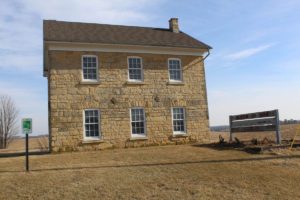Haunted Insane Asylum Part of Iowa Barn Tour
Written by Alma Gaul in June 2017
You can read the full article below or click here for the original post

The 2½-story limestone building stands alone on a rural county road in Jackson County.
It is the only structure that remains on what was once the county “poor farm,” a name given to farms set up years ago to give a home to people who, for whatever reason, did not have one.
Constructed in 1870, it was the “insane asylum,” where people judged by the state to be “incurably insane” were locked away.
Local historian Don Wentworth believes it is haunted.
“When you go up the stairs, there is a hall with chambers, or cells, on either side, and at the end of the hall is a door with a lock on it,” he said. “You have to have a key to open it.
“The (caretaker) keeps getting calls that it’s open when no one has been out there. That’s why we call it an authentic haunted place. Because there’s no way to do that.”
So why is this building on the Spring Barn Tour, a free, self-guided event to be held this Saturday-Sunday, June 10-11, sponsored by the Iowa Barn Foundation?
The foundation is a nonprofit group founded in 1997, dedicated to preserving Iowa’s rural buildings that are symbols of Iowa’s early agricultural heritage.
The answer is that because after its use as an asylum, the building was converted to agricultural purposes, used to raise hogs and chickens.
Each year, the spring tour highlights buildings in various parts of the state; this year, the Quad-City region is featured, with six barns in Jackson County and four barns and two corn cribs in Clinton County.
A building with haunted ties definitely is a first for the foundation.
The former asylum is empty inside, Wentworth said. The second-floor door that mysteriously opens without a key opens to … nothing. A person stepping through the door would fall to the ground below. Although there are no known photos of how the building looked when it was built, Wentworth assumes the door originally opened to a balcony or landing with stairs to the ground.
One of the windows still contains a steel grate, making it impossible for anyone inside to get out.
During the late 1800s, people with mental illnesses were regarded as hazards to themselves and to others who needed to be locked away, Wentworth said.
“And there are stories of widows who were committed by their families to get their hands on their money,” he said.
The building was restored in 1993 and is listed on the National Register of Historic Places.
Ghosts, Hauntings, & Cheap Books: Sign Up For My Monthly Newsletter Today.
Enjoy this Free Red Plague Sneak Peek PDF full of excerpts and extras!
<3 Anna
